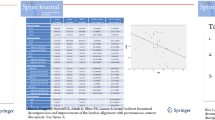Abstract
Background
The treatment of symptomatic degenerative disc disease of the lumbar spine in elderly patients by standard surgical methods is often limited due to severe comorbidities (e.g., cardiopulmonary disease, hypertonia, diabetes). Minimally invasive procedures are more acceptable in this population, since they reduce surgical morbidity and the risk of complications. The percutaneous cement discoplasty (PCD) technique was introduced by the authors to treat dynamic (and angular) instability of the symptomatic lumbar segment by injecting bone cement (polymethylmethacrylate, PMMA) into the disc spaces showing vacuum phenomena via a posterolaterally positioned Jamshidi needle. The aim of this article is to describe the indication, method, and clinical results of PCD.
Method
A total of 81 patients were treated with PCD in a tertiary care referral center over a 6-year period. The current study includes the first group of 47 consecutive patients to complete a pre- and postoperative questionnaire booklet regarding leg and back pain using the visual analog scale (VAS) and the Oswestry disability index (ODI) questionnaire.
Results
A total of 130 discs in these 47 patients were treated with PCD. The majority of patients reported a reduction in their lower back and leg pain (69 % and 66 %, respectively; p < 0.02) postoperatively. At 6-month follow-up, 61 % of patients had a minimum 10-point reduction in their ODI scores (p < 0.01).
Conclusion
Elderly patients with symptomatic dynamic foraminal stenosis and vacuum phenomenon in the intervertebral disc are suitable candidates for PCD, particularly if they represent high-risk patients for open surgery.
Zusammenfassung
Hintergrund
Die operative Behandlung einer symptomatischen degenerativen lumbalen Bandscheibenerkrankung bei älteren Patienten ist limitiert, da häufig schwere Komorbiditäten bestehen (z. B. kardiopulmonale Erkrankungen, Hypertonie, Diabetes). In dieser Population sind minimal-invasive Verfahren besser geeignet, da hierdurch die operative Morbidität und das Komplikationsrisiko gesenkt werden. Die Technik der perkutanen Zement-Diskoplastie („percutaneous cement discoplasty“, PCD) wurde von den Autoren eingeführt, um dynamische (und anguläre) Instabilitäten des symptomatischen Lendenwirbelsegments zu behandeln, indem Knochenzement (PMMA) mittels einer posterolateral positionierten Jamshidi-Nadel in die Bandscheibenzwischenräume, welche ein Vakuumphänomen aufweisen, injiziert wird. Ziel dieses Beitrags ist es, Indikation, Methode und klinische Ergebnisse der PCD zu beschreiben.
Methoden
Während eines 6-Jahres-Zeitraums wurden 81 Patienten in einem tertiären Behandlungszentrum mittels PCD behandelt. In der aktuellen Studie wurde die erste Gruppe mit 47 konsekutiven Patienten eingeschlossen, die unter Verwendung der visuellen Analogskala (VAS) und des Oswestry-Disability-Index (ODI) einen prä- und postoperativen Fragebogen bezüglich Bein- und Rückenschmerzen ausgefüllt hatten.
Ergebnisse
Bei diesen 47 Patienten wurden insgesamt 130 Bandscheiben mittels PCD behandelt. Die Mehrzahl der Patienten (69 % und 66 %) berichtete postoperativ über eine Reduzierung ihrer Schmerzen im unteren Rückenbereich und in den Beinen (p < 0,02). Beim 6-Monats-Follow-up wiesen 61 % der Patienten eine Reduzierung des ODI-Scores von mindestens 10 Punkten auf (p < 0,01).
Schlussfolgerung
Ältere Patienten mit symptomatischer dynamischer Foramenstenose und Vakuumphänomen der Bandscheiben sind geeignete Kandidaten für eine PCD, insbesondere wenn bei einem offenen Eingriff für diese Patienten ein hohes Risiko besteht.





Similar content being viewed by others
References
Cain CM, Schleicher P, Gerlach R et al (2005) A new stand-alone anterior lumbar interbody fusion device: biomechanical comparison with established fixation techniques. Spine 30:2631–2636
Cloyd JM, Acosta FL Jr, Ames CP (2008) Complications and outcomes of lumbar spine surgery in elderly people: a review of the literature. J Am Geriatr Soc 56:1318–1327
Deyo RA, Mirza SK, Martin BI et al (2010) Trends, major medical complications, and charges associated with surgery for lumbar spinal stenosis in older adults. JAMA 303:1259–1265
Dipaola CP, Molinari RW (2008) Posterior lumbar interbody fusion. J Am Acad Orthop Surg 16:130–139
Dolan P, Luo J, Pollintine P et al (2013) Intervertebral disc decompression following endplate damage: implications for disc degeneration depend on spinal level and age. Spine 38:1473–1481
Hou Y, Luo Z (2009) A study on the structural properties of the lumbar endplate: histological structure, the effect of bone density, and spinal level. Spine 34:E427–E433
Keiler A, Schmoelz W, Erhart S et al (2014) Primary stiffness of a modified transforaminal lumbar interbody fusion cage with integrated screw fixation: cadaveric biomechanical study. Spine 39:E994–E1000
Mydlarz D (2012) Degenerative disc disease, active component, U.S. Armed Forces, 2001–2011. MSMR 19:6–9
Perez-Cruet MJ, Hussain NS, White GZ et al (2014) Quality-of-life outcomes with minimally invasive transforaminal lumbar interbody fusion based on long-term analysis of 304 consecutive patients. Spine 39:E191–E198
Rosen DS, O’toole JE, Eichholz KM et al (2007) Minimally invasive lumbar spinal decompression in the elderly: outcomes of 50 patients aged 75 years and older. Neurosurgery 60:503–509; discussion 509–510
Sobottke R, Aghayev E, Roder C et al (2012) Predictors of surgical, general and follow-up complications in lumbar spinal stenosis relative to patient age as emerged from the Spine Tango Registry. Eur Spine J 21:411–417
Thome C, Zevgaridis D, Leheta O et al (2005) Outcome after less-invasive decompression of lumbar spinal stenosis: a randomized comparison of unilateral laminotomy, bilateral laminotomy, and laminectomy. J Neurosurg Spine 3:129–141
Varga P, Jakab G, Bank A et al (2007) Surgical treatment of symptomatic pathology of the ageing spine. In: European instructional course lectures. British Editorial Society of Bone and Joint Surgery, London, pp 185–191
Author information
Authors and Affiliations
Corresponding author
Ethics declarations
Conflict of interest
P.P. Varga, G. Jakab, I.B. Bors, A. Lazary, and Z. Szövérfi state that there are no conflicts of interest. All studies on humans described in the present manuscript were carried out with the approval of the responsible ethics committee and in accordance with national law and the Helsinki Declaration of 1975 (in its current, revised form). Informed consent was obtained from all patients included in studies,
Additional information
The German translation of this article can be found under dx.doi.org/10.1007/s00132-015-3092-1
Rights and permissions
About this article
Cite this article
Varga, P., Jakab, G., Bors, I. et al. Experiences with PMMA cement as a stand-alone intervertebral spacer. Orthopäde 44 (Suppl 1), 1–8 (2015). https://doi.org/10.1007/s00132-014-3060-1
Published:
Issue Date:
DOI: https://doi.org/10.1007/s00132-014-3060-1




